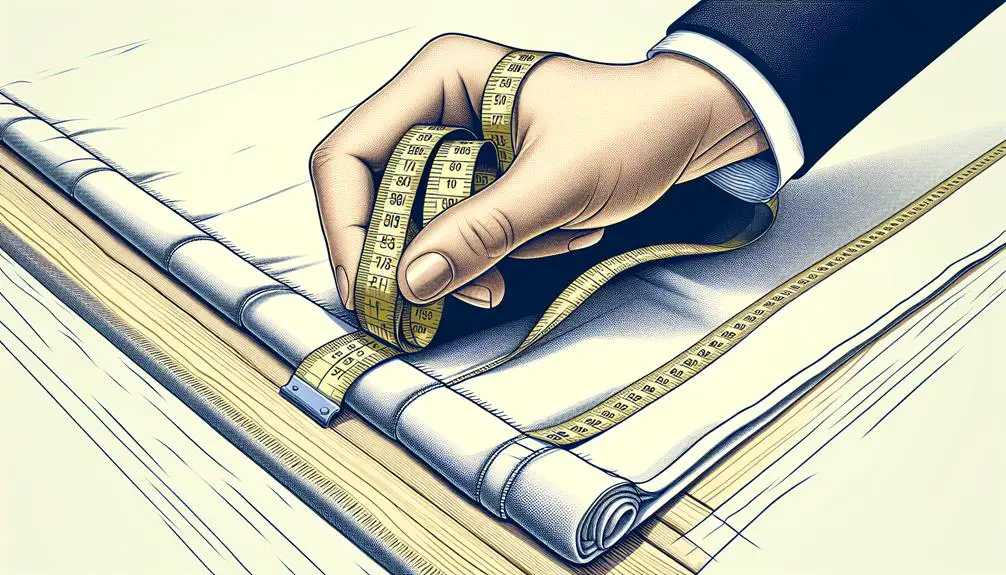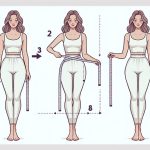When measuring a hem, accuracy is crucial for achieving a polished and professional finish. The correct length ensures your clothing hangs and drapes well on your body. Mastering the art of hem measurement involves simple yet essential steps that can greatly impact the overall look and fit of your garment.
Let's explore these steps together to help you perfect your sewing projects.
Table of Contents
Key Takeaways
- Accurate hem measurement ensures a professional finish and well-fitted garment.
- Use proper tools like sewing tape measure and pins for precise measurements.
- Different hem styles impact the garment's look and fit, choose based on personal style.
- Finish hems neatly by trimming excess fabric, pressing, and using matching thread for a polished result.
Importance of Accurate Hem Measurement
Accurately measuring a hem is crucial for ensuring a well-fitted garment that exudes professionalism and style. Using a tape measure correctly is the first step in achieving this. When measuring a hem, especially for pants or skirts, it's essential to start from the crotch seam down to the desired length. Precise measurements guarantee that the final hemline falls perfectly where intended.
In the realm of sewing, the accuracy of your hem measurements can make or break the final look of your garment. Ensuring that the hem is even all around requires meticulous attention to detail. Using a sewing gauge can assist in maintaining consistency throughout the hem.
When you take the time to measure your hems accurately, you elevate the overall appearance of your clothing. Crooked or uneven hems can cheapen the look of even the most well-made garment. By mastering the art of hem measurement, you set yourself up for success in creating polished and professional attire.
Tools Required for Hem Measurement
To ensure precise hem measurements, essential tools like a sewing tape measure, pins, and a ruler are indispensable. Pins are crucial for holding the fabric in place securely during measurement, ensuring accuracy. Straight pins help create a neat fold for the hem, while the ruler or yardstick guarantees a straight and uniform finish. Pinning the fabric along the desired hemline from seam to the bottom is key to maintaining consistency. Please be sure to measure from the seam to the bottom to get an accurate length. Below is a table summarizing the key tools required for measuring a hem:
| Tools | Function | Importance |
|---|---|---|
| Sewing Tape Measure | Measures the length of the hem accurately | Essential for precise measurements |
| Pins | Secure the fabric in place during measurement | Ensures fabric stays in position |
| Ruler/Yardstick | Ensures the hem is straight and uniform | Helps achieve a neat and even finish |
Step-by-Step Guide to Measuring a Hem
When measuring a hem, it's essential to first determine the desired fabric edge for accuracy and precision. To start, measure from the bottom edge of the garment to the chosen fabric edge to establish the accurate hem length.
Once this measurement is determined, multiply it by 2 to calculate the distance from the fabric edge. Make a clear mark at this calculated distance on the fabric to ensure precise hemming.
When folding the fabric, align it to meet this marked line for a perfect hem. For double-fold hems or if aiming for a professional finish, consider using pins or clips to secure the fold in place.
Alternatively, opt for blind hem stitches for a polished look. By following these steps meticulously, you can achieve a beautifully hemmed garment with accuracy and finesse.
Understanding Hem Length Variations
Understanding hem length variations is crucial when aiming for the perfect fit. Different hem styles, such as cropped or full length, play a key role in achieving the desired look.
Exploring these options allows you to tailor your garment to your unique preferences and requirements.
Hem Length Importance
Properly measuring the hem length of your clothing is crucial for achieving a polished and personalized look. Understanding the importance of hem length variations is key to tailoring your garments to perfection. Different hem lengths can completely transform the style and fit of your pants or skirts. Here is a table to illustrate how hem length impacts the overall appearance and functionality of your clothing:
| Hem Length | Impact on Garment |
|---|---|
| Too Short | Uncomfortable fit, limited movement |
| Correct | Enhances style, provides comfort |
| Too Long | Dragging on the ground, potential damage |
Hem Style Options
Exploring various hem style options can elevate the overall look and feel of your garments, offering a range of choices to suit different preferences and occasions. When considering hem lengths, keep in mind the following:
- Ankle length hems are popular for modern looks.
- Full-length hems are classic and versatile.
- Cropped hems provide a trendy and stylish option for a variety of bottoms.
Understanding these variations allows you to customize your garments based on personal style and the type of clothing you're working with. Remember that the hemming style can significantly impact the overall aesthetic, so selecting the right length is key to achieving your desired look.
Tips for Achieving a Perfect Hem
To achieve a flawless hem, accurately measure the desired length using a sewing tape measure for precision. Once you have this measurement, consider multiplying it by 2 to determine the fabric edge distance. Mark this calculated distance on your fabric and then fold the fabric precisely to meet this line. Using pins or clips for double-fold hems or opting for blind hem stitches can elevate your hem to a professional level.
Neatness is key when folding the fabric. Make sure the fabric is folded evenly to create a polished finish. By paying attention to these details and taking the time to fold and secure your hem accurately, you can ensure a well-executed and visually pleasing result. Remember, the little extra effort in measuring and folding will make a significant difference in achieving a perfect hem that enhances the overall look of your garment.
Common Mistakes in Hem Measurement
Making accurate measurements is crucial when hemming to avoid common mistakes that can compromise the final look of your garment. Here are some common mistakes to watch out for:
- Uneven Lengths: Incorrectly measuring the hem can result in one side being longer than the other, giving your garment an unprofessional finish.
- Fabric Stretch or Shrinkage: Not accounting for the potential stretch or shrinkage of the fabric can lead to inaccurate hem measurements once the garment is worn or washed.
- Rushing the Process: Taking shortcuts during the measuring process can result in errors, leading to the need for additional adjustments later on. It's essential to take your time and ensure accuracy from the start.
Avoiding these mistakes will help you achieve a well-fitted and polished hem that enhances the overall appearance of your garment.
Adjusting Hem Length for Different Garments
After avoiding common mistakes in hem measurement, adjusting the hem length for different garments requires precision and attention to detail.
When hemming pants, it's crucial to measure from the bottom edge to the desired fabric edge accurately. To determine the fabric edge distance needed for the hem, multiply the desired hem measurement by 2. Once calculated, make a mark at this distance and fold the fabric to meet the marked line for a perfect hem.
For a professional finish, consider using pins or clips for double-fold hems or opt for blind hem stitches. These steps ensure precision when adjusting hem length for various garments.
Hem Measurement FAQs
Let's talk about some common hemming mistakes and the best tools for measuring hems. Understanding these aspects can help avoid errors and ensure accurate measurements for a flawless finish.
Common Hemming Mistakes
When hemming garments, avoiding common mistakes is crucial for achieving a polished and professional finish. Here are three common hemming mistakes to watch out for:
- Uneven hems: Failing to ensure the hem is even around the entire garment can result in an unbalanced look.
- Incorrect measurements: Using inaccurate measurements can lead to pants being too short or too long after hemming, causing frustration and potentially ruining the garment.
- Crooked stitching: Sewing the hem unevenly or at an angle can detract from the overall appearance of the garment and give it an unprofessional finish.
Best Tools for Measuring
To ensure accurate and precise hem measurements, the best tool to use is a sewing tape measure. It provides flexibility and ease in measuring various lengths accurately.
When measuring, start from the bottom edge and extend the tape measure to the desired fabric edge for precise results. To determine the fabric edge distance, simply multiply the desired hem measurement by 2. Marking this calculated distance on the fabric helps in folding it accurately.
For a polished finish, especially with double-fold hems or blind hem stitches, consider using pins or clips to secure the fabric in place. These tools and techniques will assist you in achieving professional-looking hems with precision and finesse.
Frequently Asked Questions
How Do You Measure Leg Length for Hemming Pants?
To measure leg length for hemming pants, I start at the crotch and measure down to the desired hem length. Using a sewing tape measure, I ensure accuracy. Pinning the mark before hemming guarantees a tailored finish.
How Do You Mark Where to Hem Pants?
I mark where to hem pants by measuring the desired length accurately, multiplying it by 2, making a precise mark, and folding the fabric neatly. It's like creating a roadmap for tailoring – precise and essential for a polished finish.
How Do You Mark a Hemline?
To mark a hemline, I use a fabric marker to make a precise mark at the desired length. Double-check the measurement for accuracy and consistency across the fabric. Ensuring a straight finish is key.
How Do You Measure Hem to Hollow?
I'll show you the best way to measure hem to hollow. It's crucial for a perfect fit. Following these steps ensures precision: use a flexible tape measure, consider style and height, and double-check for accuracy.
- The Use of Nonwovens in Construction and Civil Engineering - July 11, 2025
- The Use of Nonwovens in Construction and Civil Engineering - July 11, 2025
- The Use of Nonwovens in Construction and Civil Engineering - July 11, 2025






